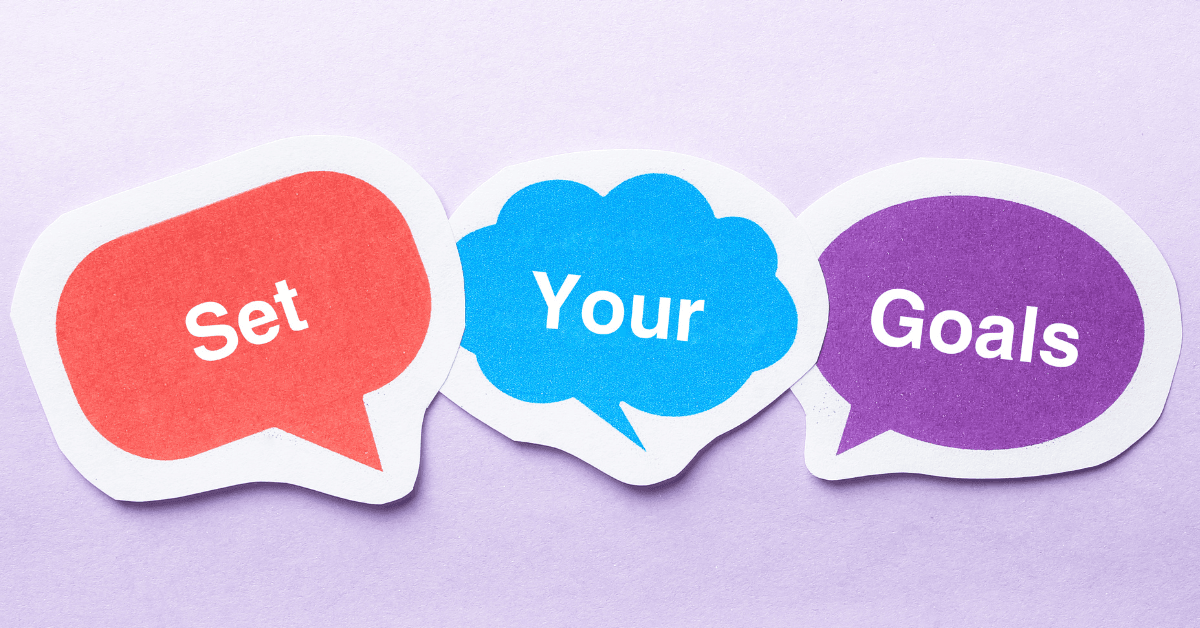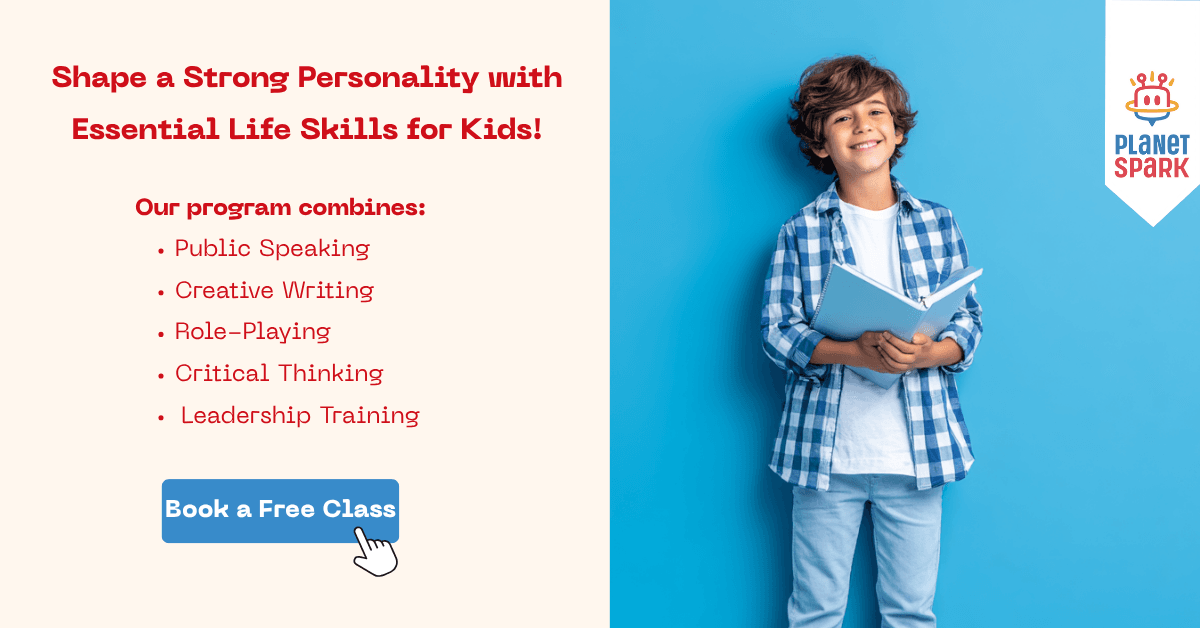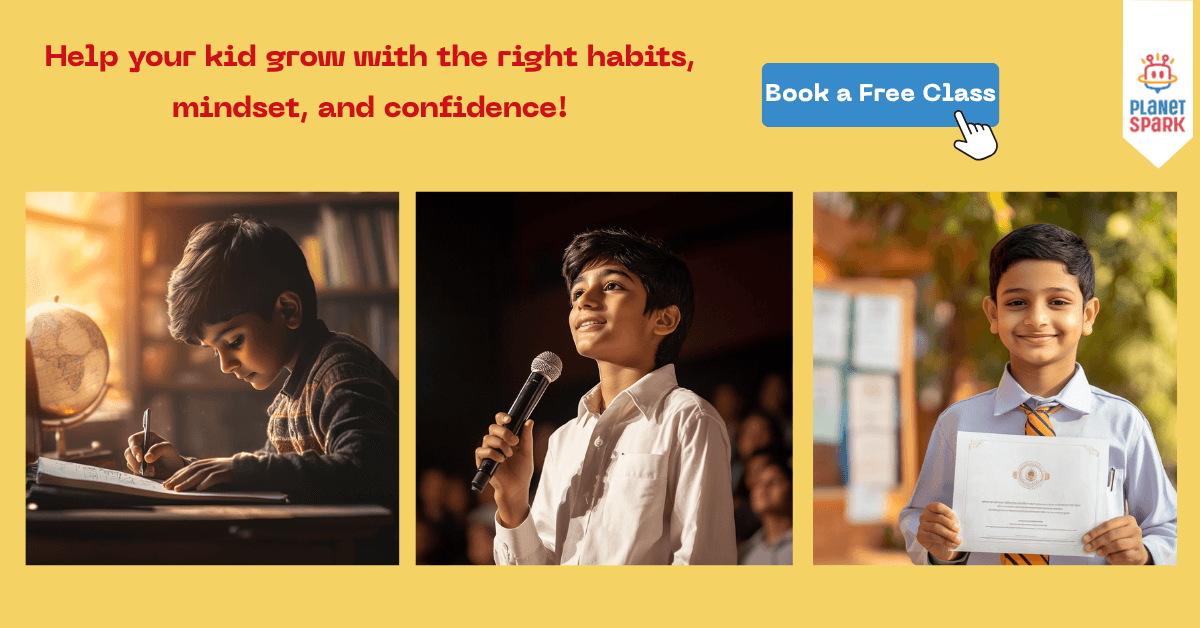5 Powerful Ways to Achieve Your Goals (With Examples) for Students

Table of Contents
- 5 Powerful Ways to Achieve Your Goals (With Examples)
- 1. Start with Small, Specific Goals
- 2. Let Children Choose Their Big Goal
- 3. Create a Goal Ladder (Break It Down)
- 5. Measure Progress and Celebrate Small Wins
- What Is Goal Setting and Why Is It Important for Kids?
- Why Is Goal Setting Crucial for Your Child’s Success?
- How to Teach Goal Setting to Your Child (A 5-Step Plan)
- The PlanetSpark Edge: Building Goal-Driven Personalities
- Conclusion
- FAQs: 5 Powerful Ways to Achieve Your Goals
Every child has the potential to achieve greatness but potential alone isn’t enough. As a parent, you may have noticed your child is bright and full of ideas, yet lacks the structure to pursue those ideas to completion. This is where goal setting becomes a critical life skill.
In this blog, we’ll explore 5 proven ways to achieve your goals with examples, particularly for children. We’ll also guide you on how to help your child build a focused, success-driven mindset through simple, actionable techniques and how PlanetSpark’s Personality Development Program can be the ideal launchpad.
5 Powerful Ways to Achieve Your Goals (With Examples)
Let’s explore practical ways children (and adults) can achieve their goals along with real-world examples that are easy to implement.
1. Start with Small, Specific Goals
Children are often enthusiastic but can feel overwhelmed when faced with large, vague goals. Starting with small, clearly defined goals builds momentum and a sense of achievement, which is crucial in developing a child's confidence and commitment.
When goals are bite-sized, they become less intimidating. Kids feel capable, and success becomes visible and attainable. This boosts their intrinsic motivation one of the most powerful drivers of consistent behavior.
- Tip:: Instead of setting an abstract goal like “I want to get better at English,” help your child define it: “I will learn and correctly use 5 new English words in sentences this week.”
- Example:
Big Goal: Score higher in Science.
Small Goal: Revise one science concept and answer 3 related questions every day after school.
Each small goal becomes a building block of the larger goal. Over time, these little wins form a foundation for long-term success.
2. Let Children Choose Their Big Goal
When children work toward goals they’ve chosen themselves, their engagement, ownership, and persistence skyrocket. If the goal comes from an external source (like a parent or teacher), kids may comply but lack motivation.
Self-chosen goals foster autonomy, responsibility, and creativity. It also helps children begin to understand themselves better what excites them, what they value, and what they’re willing to work hard for.
- Tip: Help your child reflect by asking: What makes you feel proud or happy?
What would you like to improve or learn this year?
What would you feel excited about achieving on your own?
Let them write down or draw their big goal on a vision board or journal.
- Additional Example:
A child who loves performing might set a goal like:
“I want to confidently sing or act in my school annual day.”
This is much more meaningful than pushing them to “just participate.”
Make your child be more disciplined by learning ways of self improvement.
3. Create a Goal Ladder (Break It Down)
A big goal can seem daunting without a clear path. When you break it into incremental steps, your child can focus on one milestone at a time. This approach makes large tasks feel manageable and gives your child frequent opportunities to succeed.
These small wins are essential. Each success increases self-efficacy your child’s belief that “I can do this.”
- Tip: Draw a “Goal Ladder” on paper. Write the main goal at the top. Below that, list each step needed to reach it. Your child can color in or tick off steps as they complete them.
- Enhanced Example: Big Goal: Improve Public Speaking
- Step 1: Speak clearly in front of a mirror.
- Step 2: Record a 1-minute self-introduction.
- Step 3: Present to parents or a friend.
- Step 4: Speak in a school activity.
- Step 5: Participate in a debate or storytelling competition.
Each step builds toward the bigger dream and your child gets used to structured thinking and execution.
4. Anticipate Challenges and Plan for Them
Obstacles are inevitable. When kids expect everything to go smoothly, a single setback can feel like failure. Teaching your child to anticipate challenges makes them more resilient, less likely to quit, and better at adapting their plans.
Kids must learn to problem-solve proactively, not just react when things go wrong.
- Tip:
Ask your child:
What could make this goal difficult to achieve?
What will you do if that happens?
Who can you ask for help?
Brainstorm solutions before the problem arises.
- Additional Example:
Goal: Learn to play the piano.
Possible Challenge: Getting frustrated with complex notes.
Plan: Break songs into smaller parts and practice 15 minutes daily instead of one long session.
This proactive planning develops grit and emotional strength critical elements for lifelong achievement.
Small Habits. Big Transformation.
From shy whispers to bold speeches watch your child grow in every session.
Book a free demo class for PlanetSpark’s personality development programme!
5. Measure Progress and Celebrate Small Wins
Tracking and celebrating progress helps children stay motivated and accountable. When kids can visually see their growth, it builds momentum and keeps the excitement alive.
Plus, regular review allows for course correction. If something’s not working, they can adapt without feeling discouraged.
- Practical Tip: Use:
A sticker chart
A progress journal
A color-coded calendar
An app that tracks goals visually
Celebrate with praise, tokens, or even mini rewards like choosing the next book or weekend activity.
- Additional Example:
- Goal: Read 20 books this year.
- Track: After each book, add a star to a bookshelf chart and let your child write one thing they loved about it.
- Reward: After 5 books, they get to pick a fun bookmark or book-themed prize.
This reinforces effort and makes the journey more joyful than the destination.
What Is Goal Setting and Why Is It Important for Kids?

Goal setting is the process of identifying something you want to achieve and making a plan to get there. It could be as small as improving handwriting or as big as becoming a scientist. Teaching kids how to set and achieve goals equips them with a toolkit for life one that improves focus, boosts self-confidence, and encourages long-term success.
“A child without a goal is like a traveler without a map.”
Why Is Goal Setting Crucial for Your Child’s Success?
Here are 5 reasons why setting goals early in life is essential:
Provides Focus, Purpose & Direction: With clear goals in mind, children develop a sense of direction and clarity. It helps them concentrate on what truly matters and ignore unnecessary distractions.
Increases Motivation: Achieving small, short-term goals builds confidence and excitement. These quick successes fuel the desire to keep going and tackle bigger challenges.
Improves Time Management: Goal setting teaches children how to organize their day and plan ahead. They learn to prioritize important tasks and reduce time spent procrastinating.
Builds Confidence: Every completed goal, no matter how small, gives a strong sense of achievement. This repeated success strengthens self-belief and encourages risk-taking.
Tracks Progress: Measurable goals allow kids to monitor how far they’ve come and what’s left. It keeps them accountable and helps celebrate meaningful milestones.
PlanetSpark helps kids transform from shy to shining, giving them the edge in both school and life.
Enroll in PlanetSpark’s Free Trial Class!
How to Teach Goal Setting to Your Child (A 5-Step Plan)

Let’s break it down into an easy framework you can use today:
Step 1: Write the Goal
Begin by encouraging your child to clearly express what they want to achieve. A good starting point is a simple and broad goal like, “I want to improve my Science grades.” This helps them identify the area they want to focus on and creates a sense of purpose.
Step 2: Make it Specific
Once the general goal is in place, guide your child to make it more specific and measurable. Instead of a vague intention, refine it to something like, “I want to score 85% or more in Science this term.” This creates a clear target and makes it easier to track progress.
Step 3: Identify Pros and Cons
Next, help your child consider both the benefits and challenges of working toward the goal. Pros could include a better understanding of science concepts and improved confidence in class. On the other hand, cons might involve less screen time and more effort spent studying. This step prepares them mentally for what’s ahead.
Step 4: Break It Down
To make the goal achievable, break it into smaller, manageable actions. These could include reviewing science notes daily, asking questions in class to clarify doubts, and taking weekly quizzes to reinforce learning. Smaller tasks make the process less overwhelming and more consistent.
Step 5: Track and Reflect
Finally, create a system to monitor progress and encourage reflection. Your child can use a progress chart, check marks, or even keep a journal to note improvements. Regular tracking not only keeps them motivated but also allows for timely adjustments if needed.
The PlanetSpark Edge: Building Goal-Driven Personalities
PlanetSpark’s Personality Development Program goes far beyond academics. It equips children with the mindset and tools they need to set, pursue, and achieve their goals.
Key Benefits:
Holistic Curriculum focused on leadership, self-awareness, and decision-making
Real-life Scenario Simulations like mock interviews and public introductions
Interactive, Activity-Based Learning no boring lectures!
Emphasis on Goal Setting with journaling, progress tracking, and feedback
Social-Emotional Learning (SEL) Integration to nurture empathy, grit, and resilience
Confidence Meter & Parent Consultations to monitor growth and customize strategies

Conclusion
Teaching kids to set and achieve goals is one of the most valuable life skills you can give them. Whether it’s building confidence, improving academics, or learning a new skill the ability to set, pursue, and achieve goals shapes successful futures.
By integrating these 5 goal-setting strategies with examples, your child will learn how to dream big and plan smart. And with PlanetSpark’s Personality Development Program, they’ll have the perfect partner on this journey.
More useful links:
FAQs: 5 Powerful Ways to Achieve Your Goals
Q. Why is goal setting important for kids?
A. Goal setting helps children develop focus, discipline, and motivation. It teaches them to plan, prioritize, and track progress. With clear goals, kids are more likely to stay organized and succeed. It also boosts their confidence and resilience.
Q. What is a simple way to teach kids about setting goals?
A. Start by encouraging children to choose a goal that excites them. Break it down into smaller steps and write them out like a checklist. Use visuals like charts or ladders to make it engaging. Celebrate their progress along the way.
Q. How can I keep my child motivated to achieve goals?
A. Make the goal fun and personal to your child’s interests. Offer regular encouragement and recognize small achievements. Help them overcome challenges by discussing obstacles in advance. Use rewards or praise to reinforce positive effort
Q. What kind of goals should kids start with?
A. Kids should begin with small, achievable goals like finishing homework on time, reading a book, or learning a new word daily. These early successes build momentum. Gradually, they can move on to bigger and more long-term goals.
Personalized Communication Report
Record a video to get a AI generated personalized communication report for your child

Hi There, want to try these
tips for your child with
LIVE with our expert coach?
Let's check your child's
English fluency

